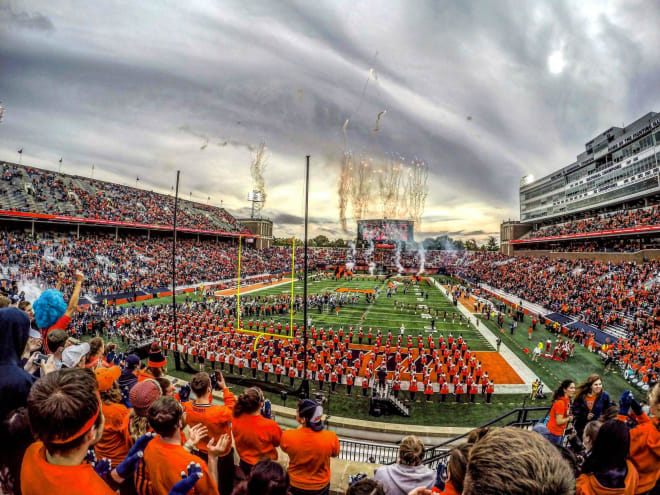Athletic directors discussing contingency plans for NCAA FB season
CHAMPAIGN – There are plenty of options on the table, if nothing else.
The brainstorming by Big Ten Conference athletic directors has taken an outside-the-box move, if the ESPN report was correct.
According to Adam Rittenberg, the league AD’s were considering playing football games in domed stadiums in Midwest cities such as Indianapolis, Minneapolis, Detroit, Milwaukee and St. Louis if the college football season is postponed until January or February. Moving games inside during the dead of winter was one plan kicked around by the AD’s, who are convening on conference calls daily.
It’s another reminder of how critical college football is to the rest of an athletic department budget, no matter if you’re Illinois or Ohio State.
“If there’s no football, that’s the worst of all scenarios,’’ said Illini athletic director Josh Whitman. “We attribute 55 to 60 percent of our revenue to football. If you lose some high percentage of that, it’s meaningful. We’d have to make some fairly dramatic changes. We’re hopeful some football can be played.’’
A condensed season, a full season in the spring of 2021. Anything. Any kind of football.
“We’re confident one of those scenarios, which all would have challenges, would be better than no football,’’ Whitman said.

So Whitman and his peers are juggling all types of concepts, planning out a matrix of decisions and game plans for each proposal and attempting to keep the ship afloat during a world pandemic that’s shutdown the sports world, just like just about everything else on Earth.
But it’s not so easy as Joe Illini thinks. There are critical decisions to make across a conference with a footprint stretching from the rural Great Plains to big city New York/New Jersey and the Capital Beltway on the Eastern Seaboard. Issues such as state rollouts on different timelines, bringing football players to a deserted campus and the possibility of playing in front of no fans force the development of several strategies as the Big Ten administrators contemplate unique decision-making in a unique time.
“You work through all those different contingency plans and all the lost revenue,’’ Whitman said. “You don’t know which scenario will play out. There are a lot of different ideas being put on the table. Right now everybody is looking at all the different scenarios, both pro and con. One of the biggest challenges is the extensive list for both, whether it’s pro or con depends on where we are with the pandemic at any given point in time.’’
With corona virus hotspots sprinkled in some states more than others, there’s a strong chance states will have different levels of recovery by later in 2020 or early 2021. How schools who have students on campus build a schedule when other schools in the league might still be in the middle of a bump in the curve is another challenge for the Big Ten and moreso the NCAA.
It makes the prospect of a level playing field nearly nonexistent.
Do Southern schools get a jump because states in the Sun Belt where governors are already easing restrictions? Do Illinois and some of the Great Lakes and Northern states have a different timeline, considering the level of emergency in cities like Chicago, Detroit and New York?
“I don’t think of it in terms of red state or blue state or Illinois being left behind,’’ Whitman said. “It’s just about the reality of college sports and the practicality of trying to resume college sports. That’s a major concern. We have daily calls with the Big Ten.
“Do you have to look out and pick a more advanced future date with some degree of confidence is the future date is one everyone can hit. Those are very active conversations.’’
So what’s the big deal, folks ask? Just let the players come back to an empty campus and play in an empty stadium. In fact, that’s the biggest snag, Whitman said. The health and safety of the athletes, coaches and support staff must be considered. With the possibility universities will remain in distance learning this fall, it creates a bad precedent to bring student athletes back to campus when it’s considered too risky for the general student body to return.
“Having student-athletes on campus without the student body would be odd and would be an inversion of our priorities,’’ Whitman said. “If it’s healthy enough for student-athletes to be here, it would be healthy enough for all students to be here. It’s one of the many wrinkles to the situation.’’
Much of the decisions will happen well above the athletic directors, Whitman said. University presidents, the NCAA and perhaps even state/federal government will also play a role.
“When will we make a decision about returning to in-person instruction and allowing students back on campus?’’ Whitman asked. “Those decisions will have as much implication for college athletics as anything.’’
According to a survey released by Brett McMurphy of watchstadium.com, 61 percent of college AD's expect the football season to start in October or November with 14 percent predicting a start in the spring semester, such as January or February.
Big 12 commissioner Bob Bowlsby already said he was against the start of college athletics before schools were given the green light to allow the student body to return. Whitman agreed with the stance.
“In this case, we have to be careful with what we message,’’ Whitman said. “If we bring student athletes back to campus and not (the student body), why are we doing that? Why are we confident it’s safe for student-athletes to be here and not the student body? That’s the decision I’m paying attention to the most.’’
But all these discussions are meaningful, because football foots the bill for so much in college athletics. It’s left everyone scrambling and brainstorming on those daily calls with Big Ten administration.
“It’s hard to project,’’ Whitman said. “It’s hard to look at what the differences would be of playing a nine-game fall season with mandated social distancing within the stadium when you only sell one ticket out of every five versus playing as 12-game schedule in the spring starting in February where you can sell every ticket in the stadium. You’re looking at gate receipts and (concessions, parking and merchandise) plus television contracts of playing a full version against a condensed schedule.’’
What about bowl season and the college football playoff, Whitman said.
“All those things are tied together,’’ he said. “All of it will have an impact on us.’’
With football so important to the budget, the think tank is working overtime, but if campus isn’t good enough for the student body, it’s not good enough for the football team.
